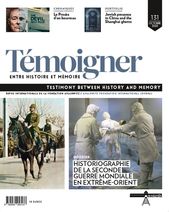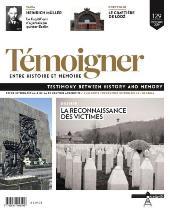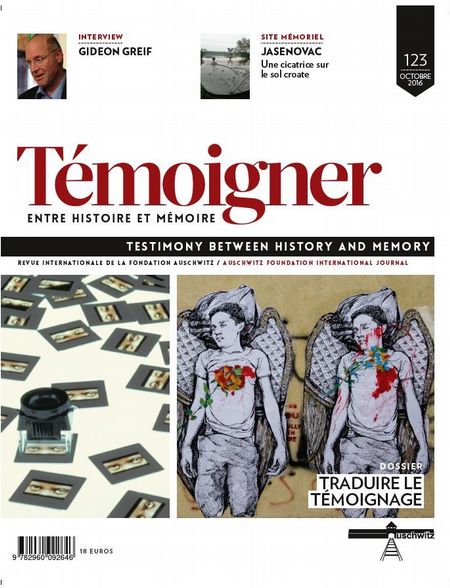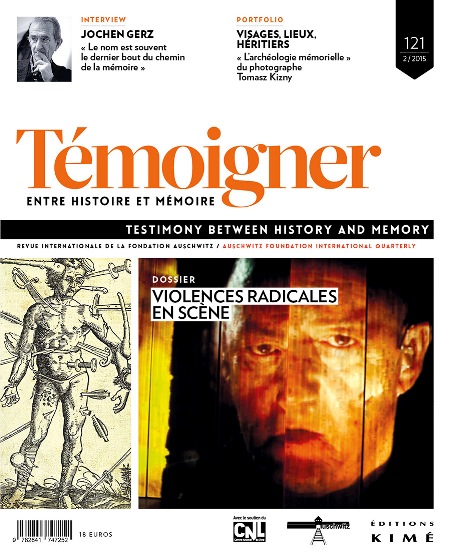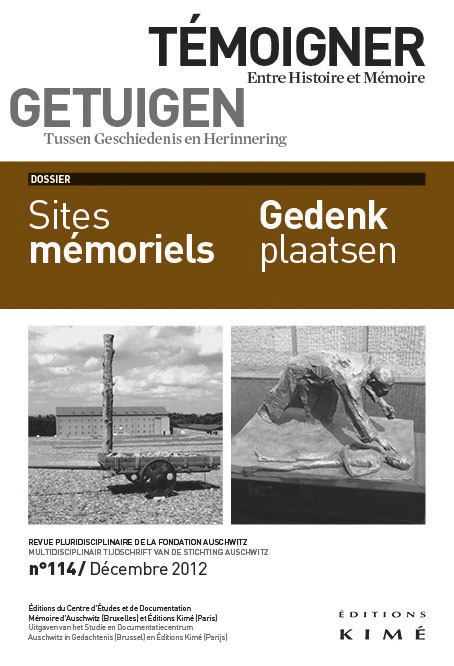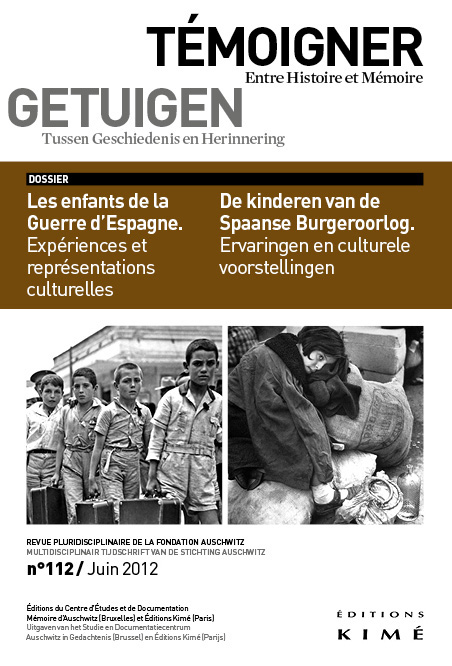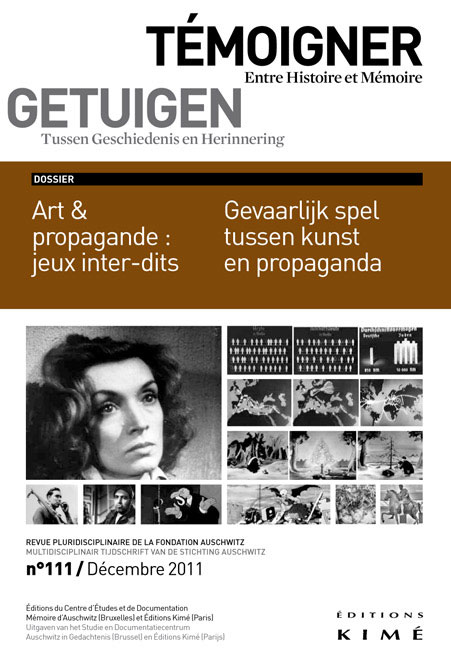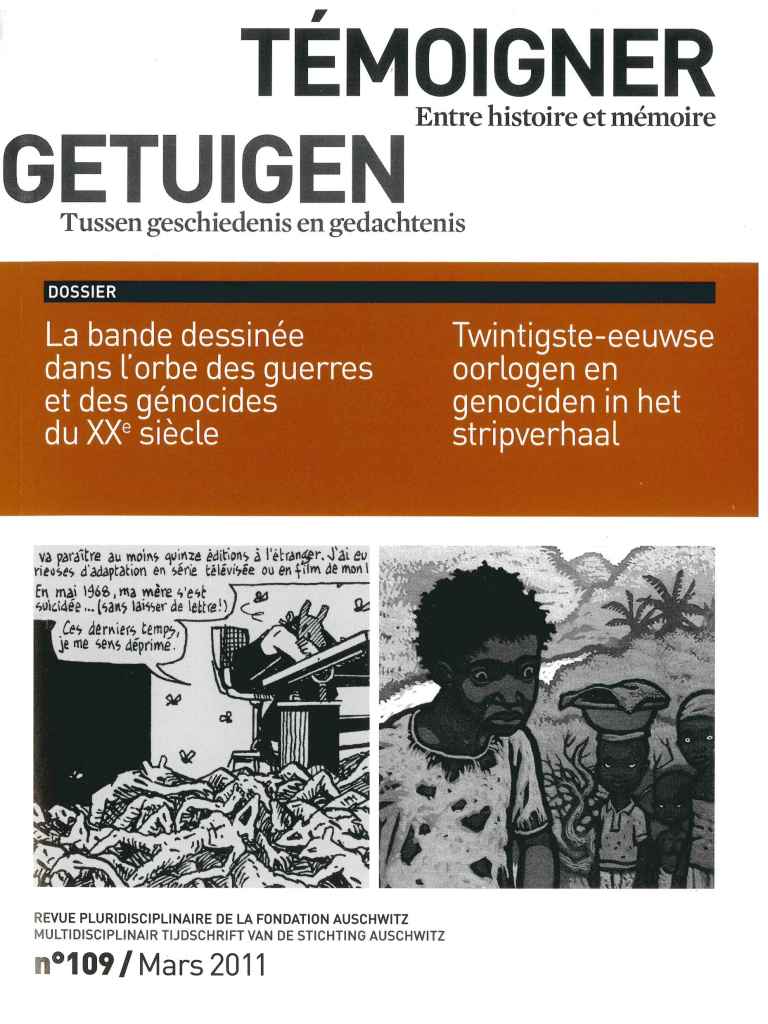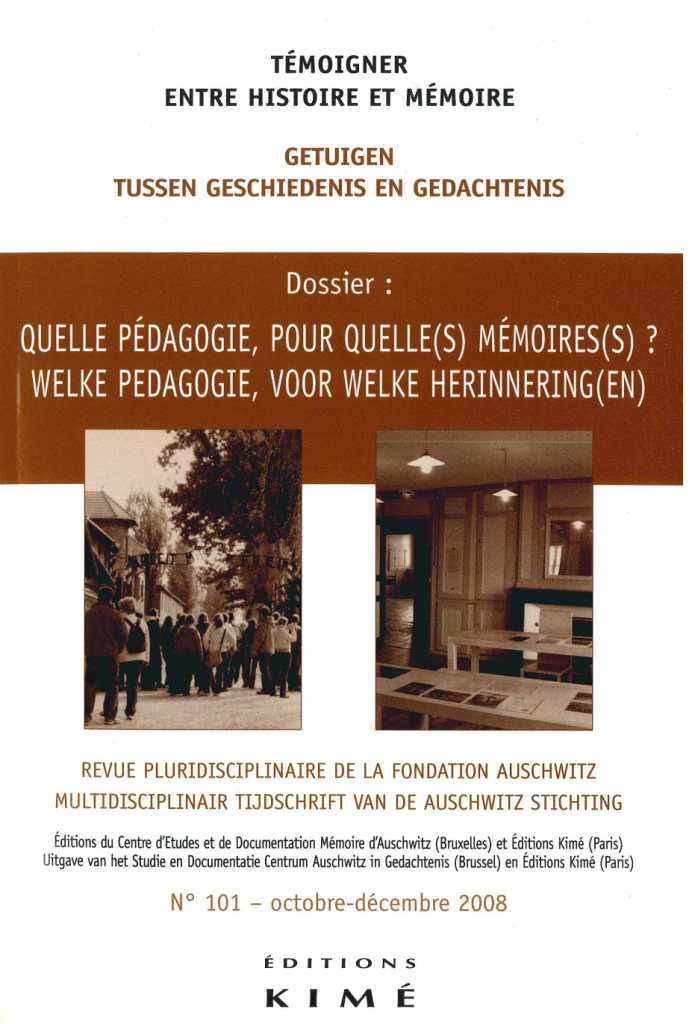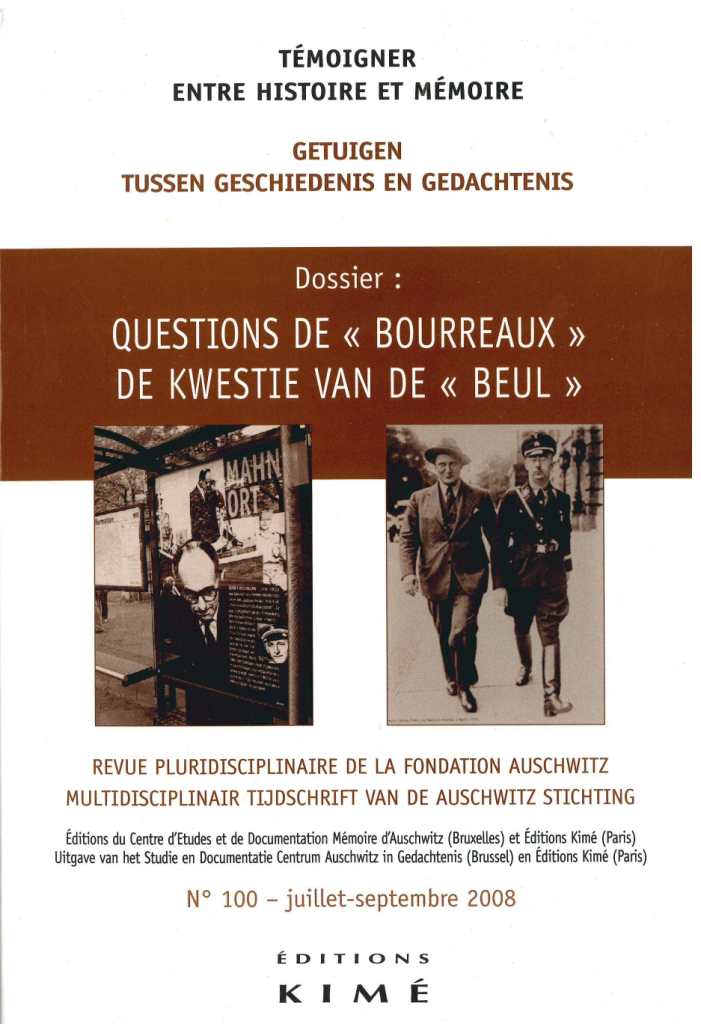Summary, abstract and full texts n° 103
Yannis Thanassekos and Philippe Mesnard, Editorial: La Mémoire, victime de l’histoire ?(pdf in French)(pdf in Dutch)
Dossier: Crimes et génocides nazis à l'écran
Coordinated by Vincent Lowy
Vincent Lowy, Une cinéphilie sanctuarisée (pdf)
-
It is time for a status report on the recurring debate concerning the way in which the cinema depicts Nazi crimes and genocides, and for envisaging new avenues of research. Such is the purpose of this dossier, which deals mainly with cinematic images in all their diversity. By studying historical trends and analyzing particular films, we hope to show the full complexity and richness of a subject which goes far beyond the traditional opposition between fiction and documentary, archives and testimony, or evidence and supposition.
Figures from history and publicized stories
Jacqueline Nacache, Le Renard du désert: Rommel à Hollywood
-
Feldmarschall Erwin Rommel, a military figure not involved in politics, was one of the few Nazi war leaders admired by the Allies, for his charisma, his tactical sense and his respect for the rules of war. Paramount exploited these qualities to make him a complex character in Five Graves to Cairo (Wilder, 1943), when the world was still at war. Still more significantly, Rommel continued to feature in films even after the war, when the focus of Allied propaganda had shifted. Rommel, who had died mysteriously after being involved in the attempt to assassinate Hitler in 1944, was an excellent subject for a film. Thus he was portrayed as a war hero in The Desert Fox (Hathaway, 1951), and reappeared a few years later in The Desert Rats (Wise, 1954).
Emma Augier, Retour à Ellis Island (pdf)
- Récits d’Ellis Island [Ellis Island Tales] (1980) is a perfect example of collaboration between a writer and a film-maker to commemorate the past, in this case the largest of the human sorting centers dealing with the massive, uninterrupted immigration of 12 million mainly poverty-stricken Europeans, who from 1892 to 1954 crowded at the gates of New York to begin a new life. Both Georges Perec and Robert Bober were marked by the Second World War and antisemitic persecution, and they were brought together by the idea of commemoration in the form of an inventory. Their film inspires reflection on memorial sites, the place of the individual in history and the poetical and metaphorical force of memory.
Nurit Levy, L’antisémitisme dans les représentations cinématographiques de l’Affaire Dreyfus
- For a long time the numerous film versions of the Dreyfus affair ignored or merely hinted at the question of antisemitism. Méliès and Ferdinand Zecca’s 1902 films and Richard Oswald’s 1930 Dreyfus in France, and even William Dieterle’s 1937 US film The Life of Emile Zola, treated the case as a judicial error and not an antisemitic crime, even though a number of these films sought to react to the rise of Nazism in Germany by expressing prosemitic attitudes. Only in José Ferrer’s 1958 I Accuse did the focus become the racial hatred which inspired the leaders of the French army to accuse Dreyfus. This new logic of commemoration is partly influenced by a growing awareness of the antisemitic genocidal aspects of the Nazis’ crimes.
- The familiar image of the little Jewish boy with his hands up before the menace of machine guns has become one of the most symbolic icons of the twentieth century. The photo was taken during the liquidation of the Warsaw Ghetto in April and May 1943. It has often been used in archive montages, and featured in such benchmark films as Nuit et brouillard [Night and Fog] (Alain Resnais, 1956), Mein Kampf (Erwin Leiser, 1960) or Le Temps du ghetto [The Time of the Ghetto] (Frédéric Rossif, 1961). But its power of evocation is such that it has also featured in films which have nothing to do with the Second World War, such as Ingmar Bergman’s Persona (1966).
Jean-Louis Comolli (interviewed by Vincent Lowy), Le temps des images (pdf)
To new objects
- Claude Lanzmann’s film Shoah (1985) has had a decisive influence on a number of members of the new generation of French film-makers, including Arnaud Desplechin, Arnaud Des Pallières, Emmanuel Finkiel and Nicolas Klotz. These young film-makers have several times evoked Lanzmann’s film and hence the Nazis’ genocidal crimes, but they have done so indirectly, subtly, not to say vaguely. This relationship, sometimes openly acknowledged, clearly shows the over-arching influence of Lanzmann’s film on the forms and thinking of contemporary cinéma d’auteur.
Julie Maeck, Enjeux et modalités de la présence de la Shoah sur Arte (pdf)
- Since the Franco-German cultural TV channel Arte was established at the beginning of the 1990’s, it has done an immense amount to publicize various aspects of the specificity of Nazi genocidal crimes. By playing a decisive part in the production of documentaries, it has thus certainly contributed to the institutionalization of the Shoah. But often Arte has displayed a lack of rigor and imagination, by confusing the accounts of eyewitnesses and the memory of the extermination, smoothing out the rough edges relating to the role of France and opting too often for a reconciliatory history and for stereotyped accounts.
Philippe Mesnard, Des affinités cinématographiques entre sexe et nazisme (pdf)
- Collusion between sex and Nazism has been clearly visible on the big screen since the 1960’s. In some films it adds spice to the plot or provides an aesthetic aspect, while it forms the subject and even the structure of others. When the production of pornographic films exploded in the 1970’s, SS porn (or Gestaporn or Swastikaporn) emerged as a fashionable sub-genre. Other films explicitly use the affinities between sex and Nazism as a roundabout way of provoking reflection on the links between fantasizing and domination and, still more, on the gray zone.
- Dachau was the first camp opened by the Nazis, in 1933, and the US armed forces came across it at the end of April 1945. The first images of the liberation of the camps which were broadcast just after the war and shown in Germany and the rest of the world were shot there, thus becoming icons of Nazi barbarity. The shots chosen for publication must nevertheless be analyzed, as their selection and montage from among a wide range of initial photos have helped to define our ongoing perception of the "concentration camp" in general.
Other subjects
Andrea Allerkamp, « Naufrage avec spectateurs »: Discours d’Ulysse selon Adorno et Levi (pdf)
- Primo Levi’s contradiction of Theodor W. Adorno’s view that poetry could no longer be written after Auschwitz has often been quoted. Levi stressed that on the contrary, poetry must be given the task of maintaining life. But despite their lack of reciprocal references, these two evocations of Ulysses, which bear witness to the extermination in very different ways, communicate with one another. The Dialectic of Enlightenment is based essentially on the idea of the return so as to reveal the dialectic between myth and enlightenment. Adorno updates Homer’s myth with the aid of associations, and thus widens the concept of modernity and establishes criteria for the adaptation of Ulysses as homo oeconomicus. In If this is a man, on the other hand, the recitations of Dante recall that the voyage of Ulysses interrupts the metaphysical circle. For Levi the cunning of Ulysses does not bear witness, in the realistic style of the nineteenth century, to the inter-lacing of myth and enlightenment, but instead to an academic wisdom which can only be expressed in poetry.
Discussion
François Rastier, Euménides et pompiérisme – Refus d’interpréter (pdf)
- Our goal in questioning the interpretations of Jonathan Littell’s best-seller is to question its success. Does it not mark a development in the status of the extermination in the contemporary imagination, a paradoxical rehabilitation of the figure of the persecutor? What happens to the status of historical facts when they are compiled in a novel which gives a psychoanalytical reading of Nazism? To cast light on the contradictory development of European culture in this context, the contrast in the reception of The Kindly Ones in Spain, Italy and Germany underlines the doubtful aspects of the French exception.
- Two American professors of literature exchange views on two novels published recently in France, Suite Française by Irène Némirovsky, published posthumously in 2004, and The Kindly Ones by Jonathan Littell, originally published in French as Les Bienveillantes in 2006. How did the Jewish intellectuals Irène Némirowsky and her husband Michel Epstein cope with a life in contact with other individuals who collaborated, and also with German officers, and how far did they tolerate them? The debate regarding The Kindly Ones is very different, and the approach here distances itself from the fierce disputes which the book aroused in France after its initial admiring reception. For Susan Suleiman the novel fulfills its promises, but Richard J. Goslan takes a more nuanced view.
Vicky Colin, Littell relit Degrelle: comment l’ironiste dégonfle le vantard (pdf)
- In the beginning of The Kindly Ones was the word of Léon Degrelle and a book, Le sec et l’humide [The Wet and the Dry] (Gallimard 2008). In this book Jonathan Littell reveals the archeological excavations he carried out after reading Degrelle, excavations from which the imposing Kindly Ones emerged a few years later. His analysis takes apart the models on which the world the Fascist Degrelle had invented for himself was based. Littell’s keyword here is irony, and his interpretation is influenced by the works of Klaus Theweleit, which makes it very easy for him to avoid any suspicion of complacency with regard to Degrelle.
Contact
Auschwitz Foundation – Remembrance of Auschwitz
Rue aux Laines 17 box 50 – B-1000 Brussels +32 (0)2 512 79 98
+32 (0)2 512 79 98 info@auschwitz.be
info@auschwitz.be
BCE/KBO Auschwitz Foundation: 0876787354
BCE/KBO Remembrance of Auschwitz: 0420667323
Office open from Monday to Friday 9:30am to 4:30pm.
Visit only by appointment.
![]()
![]()
![]()
![]()
![]()
Become a member
To become a member of Remembrance of Auschwitz ASBL, please contact us and transfer the sum of €50.00 to our account IBAN: BE55 3100 7805 1744 – BIC: BBRUBEBB with the communication: ‘Membership fee 2025’. The membership includes two issues of 2025 of our scientific journal.
DONATIONS
Donations of €40.00 or more (in one or more instalments) qualify for tax exemption for Belgian taxpayers.
In communication, please specify that it is a ‘Donation’ and mention your National Number which is required since 2024 to benefit from the tax exemption.
Subscribe
Error : Please select some lists in your AcyMailing module configuration for the field "Automatically subscribe to" and make sure the selected lists are enabled










